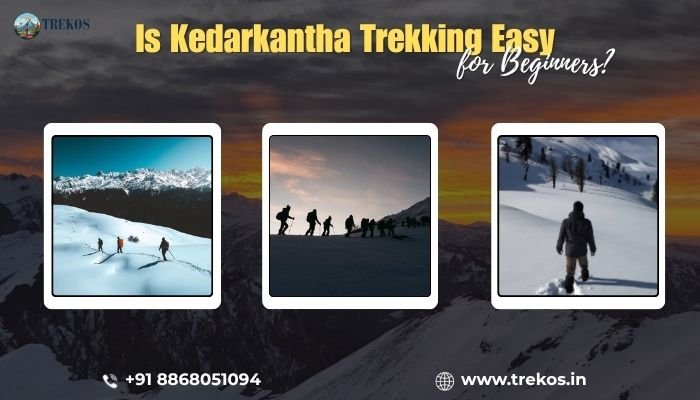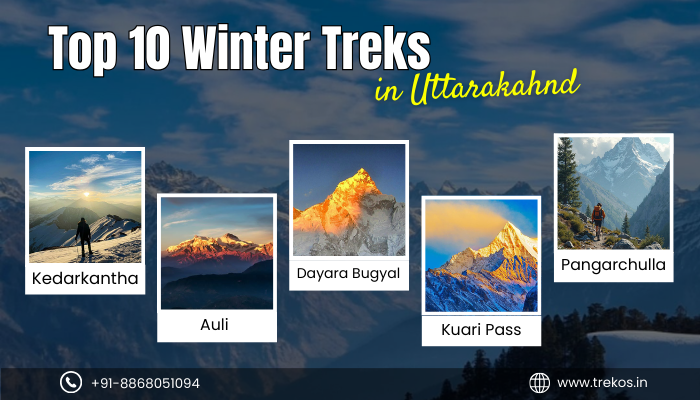The Kedarkantha Trek is one of the rare trails in the Himalayas that combines adventure, beauty, and peace. Located in Uttarkashi, Uttarakhand, this trek takes you from the charming village of Sankri to the impressive summit of Kedarkantha, which rises to around 12,500 feet. My journey on the Kedarkantha Trek was transformative. It was filled with snowy paths, pine forests, and stunning views of the Himalayas that left me amazed at every turn.
Beginning the Kedarkantha Trek – Arrival at Sankri
The adventure started when I arrived in Sankri, a quaint village that acts as the base camp for the Kedarkantha Trek. The drive from Dehradun to Sankri was captivating, with winding mountain roads, rushing rivers, and small hill settlements. Surrounded by tall pine trees and traditional wooden houses, Sankri instantly connected me to nature.
At the base, I met my trek leader and fellow trekkers. After a brief overview of the Kedarkantha Trek route, we spent the evening exploring the village and trying some local Garhwali dishes. The sunset painted the peaks in shades of orange and gold, hinting at the beauty ahead on the trail.
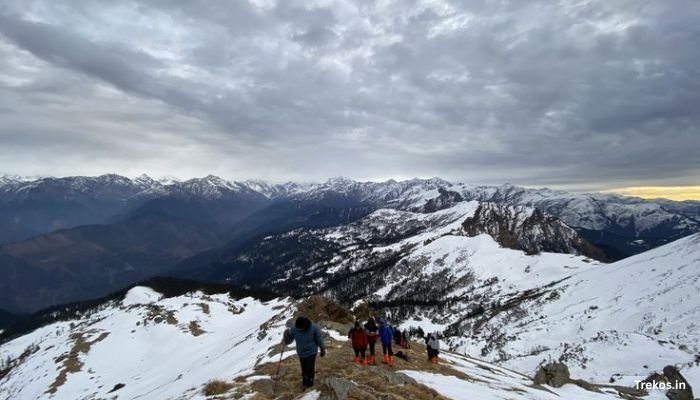
Day 1: Trek from Sankri to Juda Ka Talab
The first day of the trek began early, filled with fresh mountain air and the sound of chirping birds. Our goal was Juda Ka Talab, a serene frozen lake about 4 km from Sankri. The trail gradually rose through dense pine and maple forests, showcasing stunning views of snow-covered trees.
Walking in the snow for the first time was pure joy. The crisp sound of boots crunching in the snow mixed with the forest’s silence, creating a magical moment. By afternoon, we arrived at Juda Ka Talab. The lake was partly frozen, reflecting the tall pine trees around it. Our campsite by the lake looked like it was straight out of a postcard.
That night, stepping out of my tent, I saw a sky full of stars. The Milky Way was clear, and I understood why the Kedarkantha Trek is seen as one of the most scenic winter treks in India.
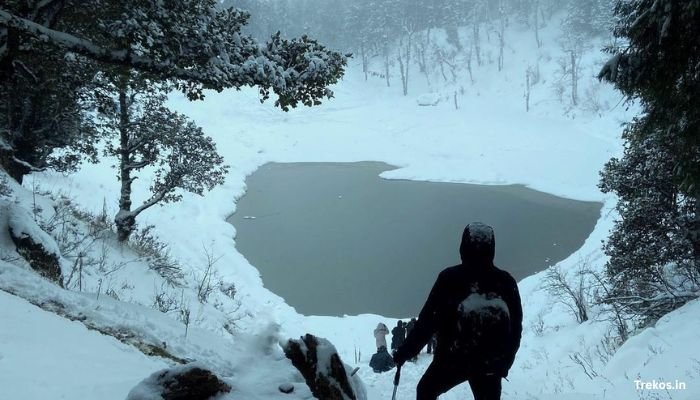
Day 2: From Juda Ka Talab to Kedarkantha Base Camp
After breakfast, we continued our journey to the base camp. The trail became steeper, but the scenery grew even more beautiful. Snow thickened along the way, and I often stopped to admire the Himalayan peaks that peeked through the clouds.
We walked through meadows blanketed in snow and reached Kedarkantha Base Camp by afternoon. At about 11,000 feet, the campsite provided a great view of the surrounding peaks — Swargarohini, Bandarpoonch, and Black Peak stood tall in the distance.
The excitement for the next day’s summit climb was palpable. Our trek leader outlined the route and safety tips. As the sun set behind the mountains, temperatures dropped sharply, but our excitement kept us warm. The night before the summit was filled with nervous energy.
Day 3: Summit Day – The Most Rewarding Part of the Kedarkantha Trek
We woke up at 3:00 AM to start our summit climb. The plan was to reach the top before sunrise. Equipped with headlamps and trekking poles, we began our ascent. The early morning silence and cold wind made the climb tough, but with each step, we got closer to our goal.
The trail was steep and shrouded in thick snow. As the horizon began to glow orange, we reached the final ridge. The first rays of sunlight hit the snow, turning everything a brilliant gold. Standing at the Kedarkantha Summit, I felt a rush of achievement. The 360-degree view of snow-capped peaks, including Gangotri, Yamunotri, and Har Ki Dun valley, was breathtaking.
This was the moment every trekker dreams of. The Kedarkantha Trek provided not just views but memories I will cherish forever. I spent a few quiet moments at the summit, absorbing the beauty and peace of the Himalayas.
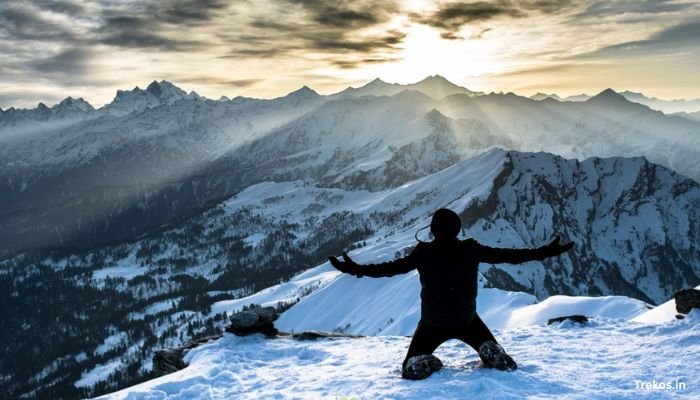
Day 4: Descent to Sankri
After taking plenty of photos at the summit, we began our descent. Going down was easier, but parting with those amazing landscapes was tough. We retraced our steps to the base camp and reached Sankri by evening.
In Sankri, the team celebrated our successful summit with local food and music. The warmth of the villagers and the satisfaction of completing the Kedarkantha Trek made for a perfect ending.
Highlights of the Kedarkantha Trek
– Scenic Forest Trails: Snow-covered pine, oak, and rhododendron forests.
– Juda Ka Talab: A stunning frozen lake perfect for camping and photography.
– Panoramic Views: 360° views of Himalayan peaks like Swargarohini and Bandarpoonch.
– Beginner Friendly: An easy-to-moderate trek suitable even for first-timers.
– Winter Wonderland: The Kedarkantha Trek between December and February offers enchanting snow trails.
Best Time to Do the Kedarkantha Trek
You can do the Kedarkantha Trek almost year-round, but winter (December to March) is the most popular season. During this time, the trail is covered in snow, making it one of India’s best winter treks. Spring (April to May) brings green meadows and blooming flowers, while autumn (October to November) offers crystal-clear views of the Himalayas.
Tips for Trekkers
– Start fitness training 2–3 weeks before the trek.
– Bring thermal wear, good trekking shoes, and a down jacket.
– Stay hydrated and follow your guide’s instructions.
– Respect nature — avoid littering and use eco-friendly products.
Conclusion
My Kedarkantha Trek journey from Sankri to the summit was more than just a mountain adventure. It was a lesson in endurance, simplicity, and gratitude. Every campsite, every step, and every sunrise brought me closer to nature. Whether you are a first-time trekker or an experienced mountain enthusiast, the Kedarkantha Trek offers an experience that will touch your soul.
If you dream of walking on snowy trails, camping under starry skies, and witnessing the beauty of Himalayan sunrises, this is a trek you should do at least once in your life.
For a safe, guided, and unforgettable experience, book your Kedarkantha Trek Package with Trekos, your trusted travel partner for Himalayan adventures.
FAQs
1. What is the difficulty level of the Kedarkantha Trek?
The Kedarkantha Trek is considered an easy to moderate trek, perfect for beginners. With gradual ascents and well-marked trails, it’s ideal for first-time trekkers looking to experience snow and stunning Himalayan landscapes.
2. What is the best time to do the Kedarkantha Trek?
The best time to do the Kedarkantha Trek is from December to April, when the entire trail is covered in snow, offering magical winter views. However, it can also be enjoyed in spring and autumn for clearer skies and blooming forests.
3. How many days are required for the Kedarkantha Trek?
Typically, the Kedarkantha Trek takes 4 to 6 days to complete, depending on the chosen itinerary. This includes travel to Sankri, acclimatization, trekking to the summit, and descending back to the base camp.
4. What is the altitude of the Kedarkantha Summit?
The Kedarkantha Trek summit stands at an altitude of approximately 12,500 feet (3,800 meters) above sea level. From the top, trekkers can witness 360° panoramic views of famous peaks like Swargarohini, Bandarpoonch, and Black Peak.
5. Is the Kedarkantha Trek suitable for beginners?
Yes, the Kedarkantha Trek is one of the best beginner-friendly Himalayan treks in India. With manageable distances, scenic campsites, and experienced guides available through operators like Trekos, even first-timers can complete it comfortably.




